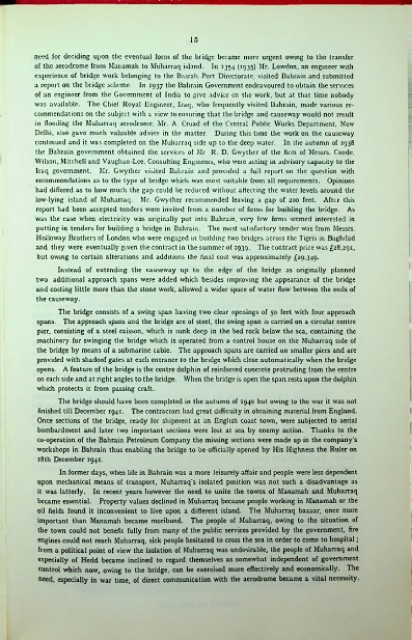Page 367 - Bahrain Gov Annual Reports (II)_Neat
P. 367
15
need for deciding upon the eventual form of the bridge became more urgent owing to the transfer
of the aerodrome from Manamah to Muharraq island. In 1354 (1935) Mr. Lowdon, an engineer with
experience of bridge work belonging to the Basrah Port Directorate, visited Bahrain and submitted
a report on the bridge scheme. In 1937 the Bahrain Government endeavoured to obtain the services
of an engineer from the Government of India to give advice on the work, but at that time nobody
was available. The Chief Royal Engineer, Iraq, who frequently visited Bahrain, made various re
commendations on the subject with a view to ensuring that the bridge and causeway would not result
in flooding the Muharraq aerodrome, Mr. A. Croad of the Central Public Works Department, New
Delhi, also gave much valuable advice in the matter. During this time the work on the causeway
continued and it was completed on the Muharraq side up to the deep water. In the autumn of 1938
the Bahrain government obtained the services of Mr. R. D. Gwyther of the firm of Messrs. Coode,
Wilson, Mitchell and Vaughan-Lee, Consulting Engineers, who were acting in advisory capacity to the
Iraq government. Mr. Gwyther visited Bahrain and provided a full report on the question with
recommendations as to the type of bridge which was most suitable from all requirements. Opinions
had differed as to how much the gap could be reduced without affecting the water levels around the
low-lying island of Muharraq. Mr. Gwyther recommended leaving a gap of 200 feet. After this
report had been accepted tenders were invited from a number of firms for building the bridge. As
was the case when electricity was originally put into Bahrain, very few firms seemed interested in
putting in tenders for building a bridge in Bahrain. The most satisfactory tender was from Messrs.
Holloway Brothers of London who were engaged in building two bridges across the Tigris in Baghdad
and they were eventually given the contract in the summer of 1939. The contract price was £28,291,
but owing to certain alterations and additions the final cost was approximately £29,349.
Instead of extending the causeway up to the edge of the bridge as originally planned
two additional approach spans were added which besides improving the appearance of the bridge
and costing little more than the stone work, allowed a wider space of water flow between the ends of
the causeway.
The bridge consists of a swing span having two clear openings of 50 feet with four approach
spans. The approach spans and the bridge are of steel, the swing span is carried on a circular centre
pier, consisting of a steel caisson, which is sunk deep in the bed rock below the sea, containing the
machinery for swinging the bridge which is operated from a control house on the Muharraq side of
the bridge by means of a submarine cable. The approach spans are carried on smaller piers and are
provided with shadoof gates at each entrance to the bridge which close automatically when the bridge
opens. A feature of the bridge is the centre dolphin of reinforced concrete protruding from the centre
on each side and at right angles to the bridge. When the bridge is open the span rests upon the dolphin
which protects it from passing craft.
The bridge should have been completed in the autumn of 1940 but owing to the war it was not I
finished till December 1941. The contractors had great difficulty in obtaining material from England.
Once sections of the bridge, ready for shipment at an English coast town, were subjected to aerial !
bombardment and later two important sections were lost at sea by enemy action. Thanks to the
co-operation of the Bahrain Petroleum Company the missing sections were made up in the company’s
workshops in Bahrain thus enabling the bridge to be officially opened by His Highness the Ruler on
18 th December 1941.
In former days, when life in Bahrain was a more leisurely affair and people were less dependent
upon mechanical means of transport, Muharraq’s isolated position was not such a disadvantage as
it was latterly. In recent years however the need to unite the towns of Manamah and Muharraq
became essential. Property values declined in Muharraq because people working in Manamah or the
oil fields found it inconvenient to live upon a different island. The Muharraq bazaar, once more
important than Manamah became moribund. The people of Muharraq, owing to the situation of
the town could not benefit fully from many of the public services provided by the government, fire
engines could not reach Muharraq, sick people hesitated to cross the sea in order to come to hospital;
from a political point of view the isolation of Muharraq was undesirable, the people of Muharraq and
especially of Hedd became inclined to regard themselves as somewhat independent of government
control which now, owing to the bridge, can be exercised more effectively and economically. The
need, especially in war time, of direct communication with the aerodrome became a vital necessity.

